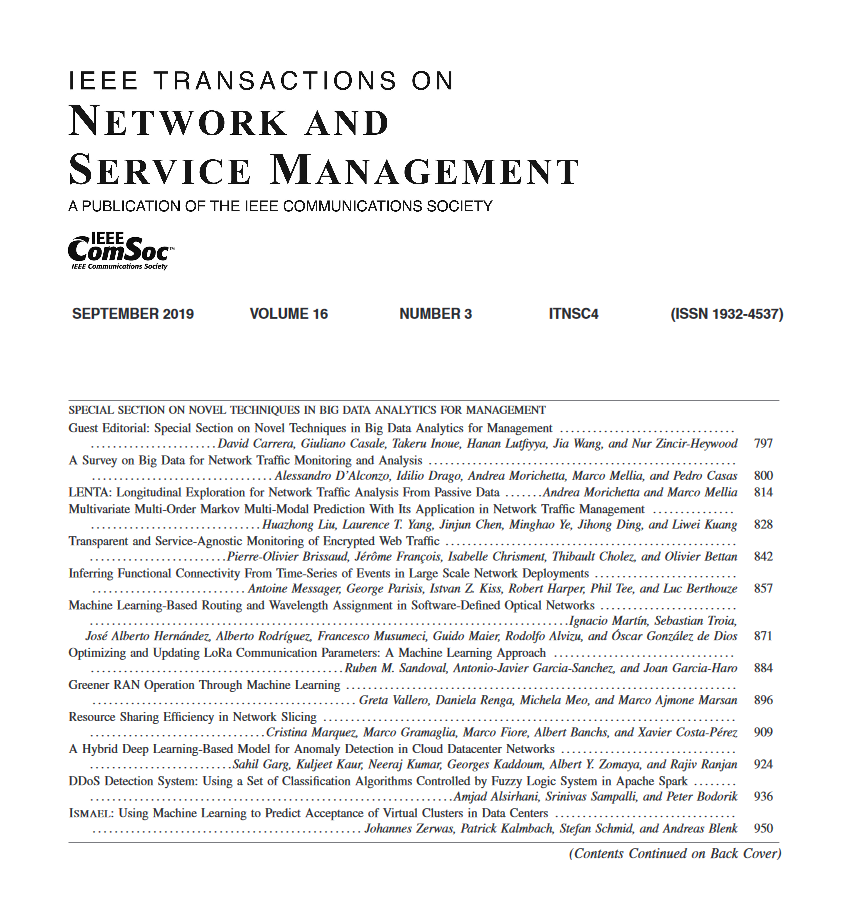Performance Modeling of IoT-Cloud Gateway Under Diverse Traffic Characteristics
IF 4.7
2区 计算机科学
Q1 COMPUTER SCIENCE, INFORMATION SYSTEMS
IEEE Transactions on Network and Service Management
Pub Date : 2024-11-04
DOI:10.1109/TNSM.2024.3489598
引用次数: 0
Abstract
The presence of diverse traffic types is well-established in IoT networks. Various probability distributions have been found to describe packets inter-arrival time contrasting with the familiar exponential distribution in traditional networks. These findings suggest the need to develop appropriate traffic models for performance analysis of IoT network systems. An essential component in IoT network is gateway as it provides connectivity to the core Internet. The IoT gateway also performs functions such as protocol translation and traffic aggregation. Therefore, efficient design of the IoT gateway is necessary for better network management. The paper presents a new analytical model, N-Gamma/M/1, for analyzing the performance of IoT gateway. The equivalence of N-Gamma/M/1 and Gamma/M/1 models is proved mathematically. Additionally, an in-depth performance evaluation of the IoT gateway under various arrival patterns is conducted through simulation. The numerical analysis of the proposed N-Gamma/M/1 model emphasizes the need for more buffers at the gateway when traffic from input devices has varying values of gamma distribution parameters. It is also noted that the IoT gateway experiences a longer mean queue length resulting in higher mean waiting time and packet loss when inter-arrival time distribution of packets follows generalized Pareto, Weibull and lognormal distributions with different parameter values. This makes the task of IoT network management challenging. Adaptive and intelligent resource allocation policies along with dynamic congestion control algorithms may provide a solution to minimize packet loss and ensure quality of service.不同流量特征下物联网云网关性能建模
在物联网网络中,各种流量类型的存在是公认的。与传统网络中常见的指数分布不同,人们发现了不同的概率分布来描述数据包的间隔到达时间。这些发现表明,需要为物联网网络系统的性能分析开发适当的流量模型。网关是物联网网络的重要组成部分,因为它提供了与核心互联网的连接。物联网网关还具有协议转换、流量聚合等功能。因此,高效的物联网网关设计对于更好的网络管理是必要的。本文提出了一种新的物联网网关性能分析模型N-Gamma/M/1。用数学方法证明了N-Gamma/M/1和Gamma/M/1模型的等价性。此外,通过仿真对不同到达模式下的物联网网关进行了深入的性能评估。所提出的N-Gamma/M/1模型的数值分析强调,当来自输入设备的流量具有不同的gamma分布参数值时,网关需要更多的缓冲区。还注意到,当数据包的到达时间分布遵循不同参数值的广义帕累托分布、威布尔分布和对数正态分布时,物联网网关的平均队列长度较长,导致平均等待时间和数据包丢失较高。这使得物联网网络管理的任务具有挑战性。自适应智能资源分配策略和动态拥塞控制算法可以提供最小化丢包和保证服务质量的解决方案。
本文章由计算机程序翻译,如有差异,请以英文原文为准。
求助全文
约1分钟内获得全文
求助全文
来源期刊

IEEE Transactions on Network and Service Management
Computer Science-Computer Networks and Communications
CiteScore
9.30
自引率
15.10%
发文量
325
期刊介绍:
IEEE Transactions on Network and Service Management will publish (online only) peerreviewed archival quality papers that advance the state-of-the-art and practical applications of network and service management. Theoretical research contributions (presenting new concepts and techniques) and applied contributions (reporting on experiences and experiments with actual systems) will be encouraged. These transactions will focus on the key technical issues related to: Management Models, Architectures and Frameworks; Service Provisioning, Reliability and Quality Assurance; Management Functions; Enabling Technologies; Information and Communication Models; Policies; Applications and Case Studies; Emerging Technologies and Standards.
 求助内容:
求助内容: 应助结果提醒方式:
应助结果提醒方式:


